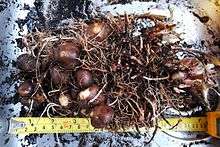Phlomoides tuberosa
| Phlomoides tuberosa | |
|---|---|
 | |
| Scientific classification | |
| Kingdom: | Plantae |
| (unranked): | Angiosperms |
| (unranked): | Eudicots |
| (unranked): | Asterids |
| Order: | Lamiales |
| Family: | Lamiaceae |
| Genus: | Phlomoides |
| Species: | P. tuberosa |
| Binomial name | |
| Phlomoides tuberosa (L.) Moench | |
| Synonyms[1] | |
|
Synonymy
| |

Phlomoides tuberosa is a perennial flowering plant in the family Lamiaceae native to China, Kazakhstan, Kyrgyzstan, Mongolia, Russia; SW Asia and Europe. Enlarged, tuberous roots give rise to erect stems to 150 cm bearing purple-red flowers.[2]
Chemistry
Phytochemical analyses of Phlomoides tuberosa have found neolignans, phenylpropanoids, triterpenes,[3] flavanoids, polyphenolics, alkaloids and the iridoid glucosides 5-desoxysesamoside, sesamoside, shanziside methyl ester and lamalbide.[4] Dried leaves of plants collected in Buryatia yielded 0.02% of essential oil with a weak aroma.[3] The seed has yielded 11.8% of oil, including 3.3% gadoleic acid and some fatty acids containing the unusual allene group, 25.1% laballenic acid and 2.9% phlomic acid.[5]
Uses
The Kalmyks are said to have eaten the cooked root, calling the plant bodmon sok.[6] Another source for Mongolia has the plant used as a folk restorative medicine against intoxication, tuberculosis, pulmonary and cardiovascular diseases and rheumatoid arthritis.[7] Buryat lamas used some part of the plant to treat diarrhoea, eye and lung disease and as a sedative.[3]
References
- ↑ The Plant List, Phlomoides tuberosa (L.) Moench
- ↑ "Flora of China". eFloras. Flora of China Project. Retrieved 8 December 2016.
- 1 2 3 Olennikov, D.N.; Dudareva, L.V.; Tankhaeva, L.M. (2010). "Chemical Composition of essential oils from Galeopsis bifida and Phlomoides tuberosa" (PDF). Chemistry of Natural Compounds. 46 (2): 316–318. doi:10.1007/s10600-010-9602-9. Retrieved 9 December 2016.
- ↑ Alipieva, Kalina Iv.; Jensen, Soren R.; Franzyk, Henrik; Handjieva, Nedjalka V.; Evstatievac, Ljuba N. (2000). "Iridoid Glucosides from Phlomis tuberosa L. and Phlomis herba-ventis L." (PDF). Zeitschrift für Naturforschung C. 55 (3/4): 137–140. Retrieved 9 December 2016.
- ↑ Aitzetmüller, Kurt; Tsevegüren, Nanzad (1998). "Phlomic Acid in Lamioideae Seed Oils" (PDF). Lamiales Newsletter (Kew) (6): 13–16. Retrieved 9 December 2016.
- ↑ Pickering, Charles (1879). Chronological History of Plants. Boston: Little, Brown, and Company. p. 793. Retrieved 8 December 2016.
- ↑ Yang, Yingbo; Gu, Lihua; Xiao, Ying; Liu, Qing; Hu, Haijun; Wang, Zhengtao; Chen, Kaixian (2015). "Rapid Identification of α-Glucosidase Inhibitors from Phlomis tuberosa by Sepbox Chromatography and Thin-Layer Chromatography Bioautography". PLoS One. 10 (2): e0116922. doi:10.1371/journal.pone.0116922. Retrieved 9 December 2016.
| Wikimedia Commons has media related to Phlomoides tuberosa. |